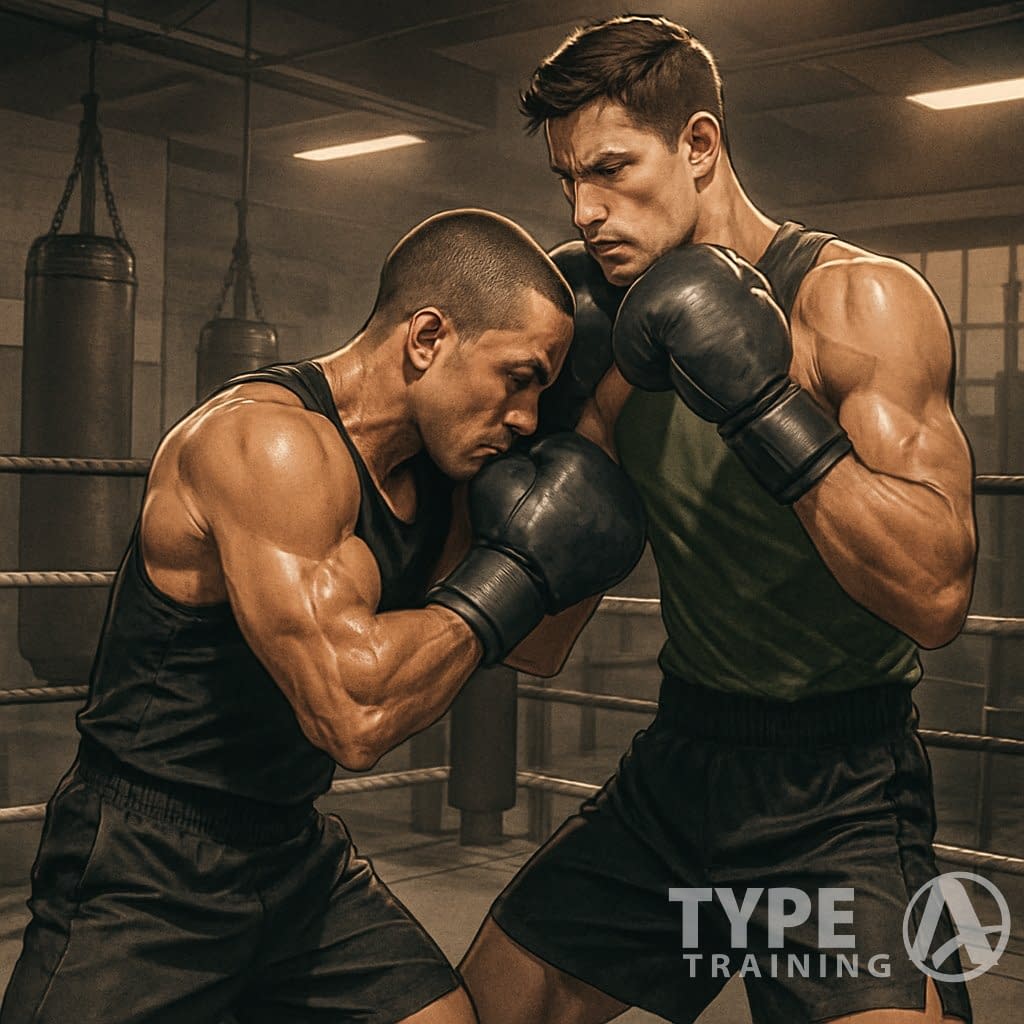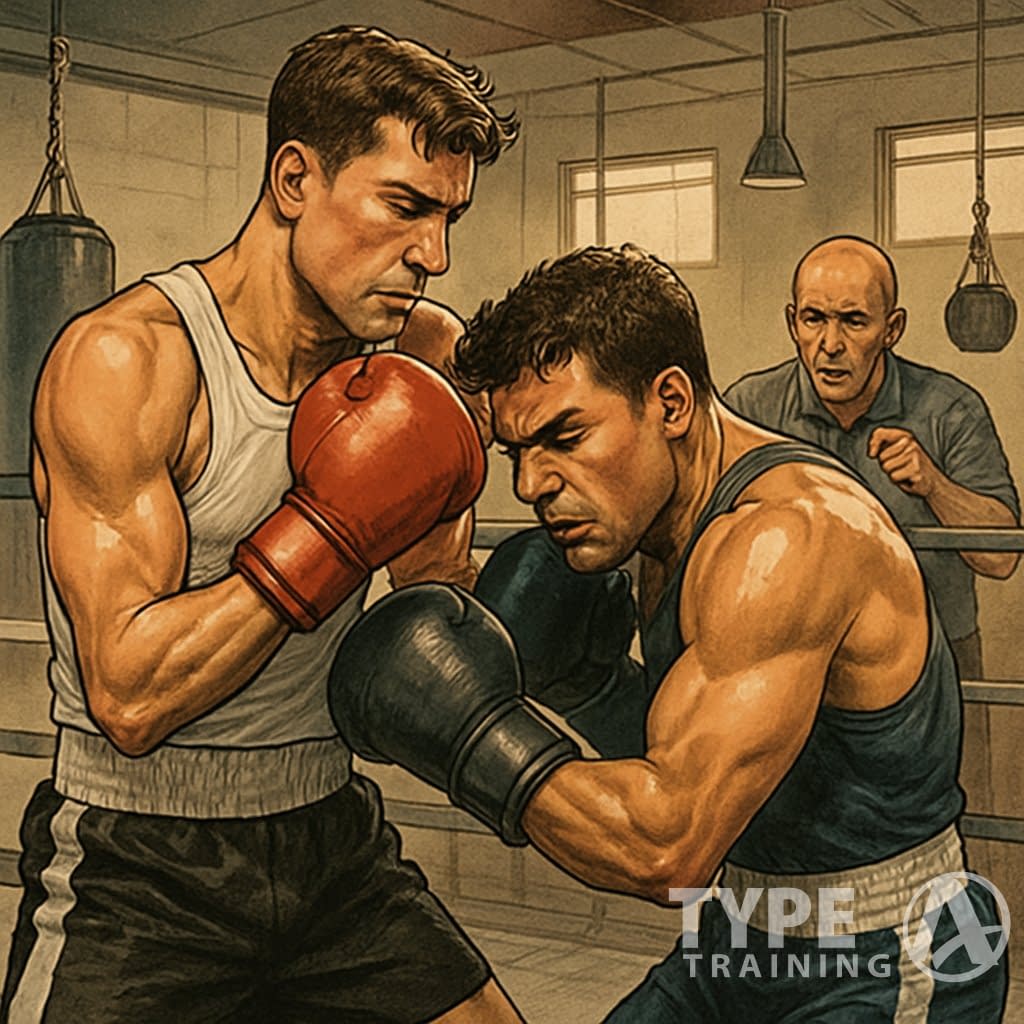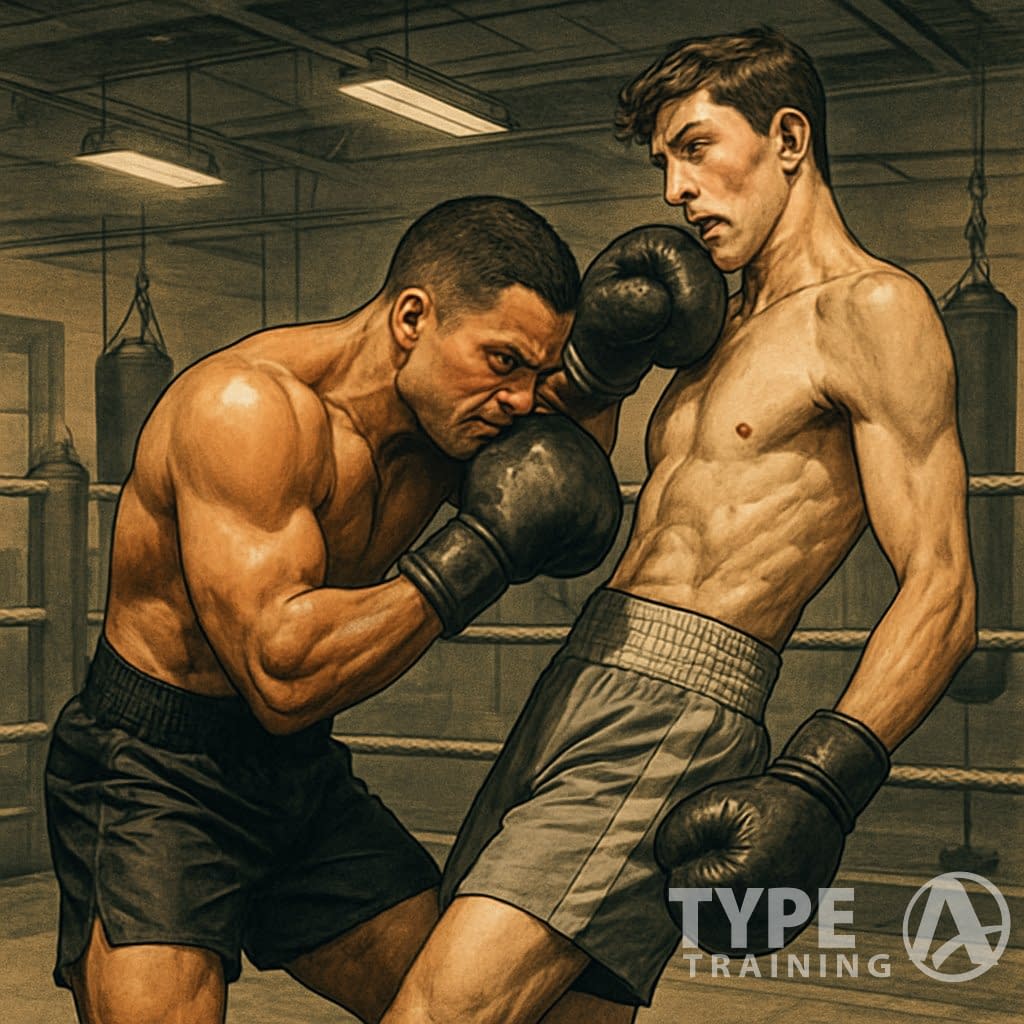Facing a taller boxer can feel like you’re fighting uphill. Every punch you throw has to travel farther, while theirs seem to snap in from a mile away.
Long arms, higher reach, and those endless jabs make closing the gap a real headache. The key to beating taller opponents is mastering inside fighting, where their reach advantage disappears and your power matters more.

If you can slip past the jab, cut off space, and work their body, you force the taller fighter into a spot they hate. On the inside, their long arms don’t work as well, their defense opens up, and they start losing their balance.
Popular posts:
With the right tactics, you can flip their size from a strength into a weakness.
This guide digs into practical ways to get inside safely, land shots up close, and defend against those reach-heavy attacks. Once you sharpen these skills, you’ll know how to pressure, counter, and outwork taller boxers who love keeping things at a distance.
Key Takeaways
- Control range by closing distance without taking unnecessary damage
- Use smart offense and defense to stay effective on the inside
- Train specific drills to adapt against different taller fighting styles
Breaking News: Jake Paul and Gervonta "Tank" Davis are set to collide in Atlanta on Nov. 14, streaming live worldwide on Netflix.
WBA Champion Gervonta Davis Meets Jake Paul in Superfight

Jake Paul to Face Gervonta Davis in November Superfight
It’s official: Jake “El Gallo de Dorado” Paul (12-1, 7 KOs), the WBA’s No. 14 ranked cruiserweight, will meet undefeated three-division champion and reigning WBA titleholder Gervonta “Tank” Davis (30-0-1, 28 KOs) in a highly anticipated bout.
The fight is scheduled for Friday, November 14 at State Farm Arena in Atlanta and will stream live worldwide on Netflix, available to all subscribers.
Background
The matchup brings together two of boxing’s most talked-about figures. Paul, who has built one of the sport’s largest followings and redefined modern fight promotion, will face his toughest challenge yet in Davis, widely regarded as one of the most dangerous punchers of his generation.
The bout also marks the culmination of a rivalry that has been building for more than four years, fueled by call-outs and speculation from both camps.
Understanding the Height and Reach Advantage
Taller boxers usually control distance with longer arms and a higher punch range. That means you’ve got to work harder just to get close enough to land clean shots, all while dodging their incoming fire.
Why Taller Boxers Are Challenging
A taller fighter almost always has a reach advantage. Their punches travel farther than yours, letting them score from a spot where you can’t hit back easily.
The jab becomes their main weapon, scoring points and keeping you stuck outside.
Because they’re taller, their punches come down at you from above your guard. That’s a pain to defend, and you have to punch upward, which takes more effort.
Many taller boxers also like to control the pace. They’ll make you chase them, burning your energy before you even get inside.
If you rush in without a plan, you’ll probably walk into straight punches. That tricky space between long-range and close-range is where most shorter boxers get caught.
Common Strategies Used by Taller Opponents
Taller boxers often build their whole game around a steady jab. The jab lets them score safely, keep you at bay, and set up their bigger shots.
- Scoring points safely
- Maintaining distance
- Setting up power shots
They’ll mix in quick one-two combos when you try to close the gap. The straight right or left cross after the jab takes full advantage of their reach.
Footwork matters too. Taller fighters will circle around the ring, making you reset every time you try to step in. That movement helps them avoid the close-range stuff where their height isn’t as useful.
Some tall boxers lean on defensive tactics like clinching if you get too close. By tying you up, they shut down your offense and reset the fight back to long range.
Key Principles of Inside Fighting Against Taller Opponents
Inside fighting against a taller boxer means you have to close space quickly, protect yourself with a strong guard, and control the position so you can dictate the exchanges. That’s how you reduce their reach advantage and create chances to land clean, effective punches.
Importance of Closing the Distance
Tall boxers rule at long range, using jabs and straights to keep you out. To beat that, you have to close the distance and fight inside their reach.
Use head movement, feints, and quick footwork to get in. Slip jabs and step in at angles—don’t just walk straight forward. Always move in behind punches, like a jab, double jab, or quick combo, so you’re not just a sitting duck.
Once you’re inside, stay busy. Short hooks and uppercuts—especially to the body—are your best friends up close. That makes the taller boxer uncomfortable and throws them off balance.
Some quick reminders:
- Slip first, then step in
- Punch on entry
- Stay tight once inside
Maintaining Effective Guard
When you’re fighting inside, your guard has to protect you from downward punches like straights and uppercuts. Keep your elbows tucked, hands high, and your guard compact.
Your forearms should block body shots, and your gloves cover your chin and temples. Move your head a little even while in guard—don’t freeze up.
Tall boxers will try to push you back with their jab or tie you up. Keep a strong base and tight arms to reduce the openings they can find. Use your guard not just for defense but to create offense, like blocking a punch then countering with a short hook to the ribs.
Controlling the Ring
Inside fighting isn’t just about throwing punches—it’s about where the action happens. You need to control where you fight.
Cut off the ring so the taller boxer can’t just circle away and reset the distance. Use lateral steps to trap them near the ropes or in a corner.
Once you get them there, keep the pressure on with short bursts and body shots. Don’t follow them in a straight line, or they’ll just escape.
If you keep pushing forward and force exchanges in close, the taller boxer won’t have time or space to use their reach. That’s when you make them fight your fight.
Entry Techniques: Getting Inside Safely
To beat a taller boxer, you have to close the gap without eating punches. That means using smart movement, good timing, and tactics that help you get past their reach while staying ready to counter.
Using Head Movement and Footwork
Head movement keeps you safe from straight shots as you come forward. Tall opponents love the jab and cross, so slipping your head off the centerline makes you tougher to hit.
Keep your footwork tight and balanced. Don’t lunge or cross your feet—you’ll just get caught. Use quick shuffle steps to move in, always ready to punch or defend.
Angles matter as much as forward pressure. Step a little to the side as you advance, forcing the tall boxer to reset. Changing the angle takes away their ability to control you with long punches.
Try this: slip, step, and punch.
- Slip the jab.
- Step forward or to the side.
- Fire a short combo to the body or head.
Employing Feints and Angles
Feints make tall fighters hesitate. A quick shoulder drop, half jab, or body twitch can draw a reaction and show you where the gaps are.
If he lifts his guard too early, you can step inside safely.
Angles work best with feints. For example, fake a jab to the head, then step left and attack the body. That forces him to turn and messes up his rhythm.
Don’t just walk in straight—tall boxers expect that and will make you pay. Feints make them second-guess, and angles keep you from getting stuck at the end of their jab.
When you combine both, you find openings to get inside without taking unnecessary shots. That puts you in charge, not just reacting to their range.
Slipping the Jab
The jab is the main weapon for a tall opponent. If you can’t deal with it, you’ll never get close.
Slipping the jab lets you get past their reach and counter at the same time. Keep your head off the centerline—a small slip inside or out is enough. Don’t overdo it and lose your balance.
Step forward as you slip. Counter right away—a body shot, uppercut, or short hook works once you’re in. That stops them from resetting and tossing out another jab.
Practice slipping both ways so you’re not predictable. Sometimes slip inside to attack the body, sometimes outside to land a hook over their arm. The goal is to turn their jab into a weakness.
Counter Punching and Offensive Tactics
You get the most control up close by making the taller boxer commit first, then punishing their mistakes. Sharp counters, steady pressure, and quick reactions to missed shots help you take away their reach.
Timing Counters Against Long Jabs
Tall fighters love using the jab to control distance. Watch for small tells—a shoulder twitch, a weight shift. Once you spot the rhythm, slip inside and fire a counter.
The best counters are short and direct. A quick right hand over their jab or a left hook to the body can throw them off. You don’t need big swings—compact shots are faster and keep you balanced.
Work on slipping both inside and outside. If you always move one way, they’ll catch on. Mix up your head movement to create more chances for clean counters.
Combining Counters with Forward Pressure
Counter punching by itself isn’t enough if you just stand there. Pair it with forward pressure to make the tall boxer uncomfortable.
Step in behind your guard, slip their jab, and fire right back. Pressure doesn’t mean charging in wild—use short steps to close distance and cut off the ring.
After each counter, follow up with another punch so they can’t reset. For example: slip the jab, counter with a right, then step in with a left hook to the body.
This combo of pressure and counters forces the tall fighter to fight at your range. They lose the space to extend their punches, giving you the edge inside.
Exploiting Openings After Missed Punches
Tall boxers tend to overcommit with long punches. When they miss, their arms take longer to return, leaving gaps you can attack.
Train yourself to spot these moments and strike right away. The best targets after a miss are the body and the head on angles.
For example: if they miss a right cross, step to the outside and land a left hook to the ribs. If they miss a jab, slip inside and throw an uppercut.
Keep your counters short and efficient. Aim to land before they recover, not to load up on power.
Attacking Strategies on the Inside
When you close the gap against a taller boxer, make every punch count. Focus on striking where they’re most vulnerable and keep steady pressure.
Targeting the Body
A tall boxer usually protects their head with long arms, but their midsection is harder to cover. Target the ribs, liver, and solar plexus to slow their movement and drain stamina.
Body shots work best when you slip past the jab. A quick step inside and a left hook to the body can break their rhythm.
Throw short, compact punches to the body instead of wide swings. This keeps you balanced and makes it tougher for them to counter.
Try a jab to the chest followed by a hook to the ribs. It’s simple but disrupts their range advantage.
Utilizing Hooks and Uppercuts
Once you’re inside, straight punches lose their edge because space is tight. Hooks and uppercuts become your go-to moves.
These punches travel at angles that get past the tall boxer’s long guard and land clean. Uppercuts work especially well if they lean forward to tie you up.
A quick uppercut to the chin can stop that and reset the exchange. Hooks to the head or body also land well after slipping under their jab.
Mix up your levels—hook to the body, then hook to the head. It forces the taller boxer to defend up and down, making them slower to react.
Stay close so your punches land before they can extend their arms.
Maximizing Punch Volume
Inside fighting rewards activity over single hard shots. If you pause, a tall boxer can reset and push you back with jabs.
High punch volume keeps them defensive and unable to control the pace. Work in short bursts of 3–5 punches, mixing body and head targets.
Even if not every punch lands, the pressure stops them from regaining range. Keep your punches tight and efficient, not wide or looping.
Use compact combinations like uppercut–hook–hook or body–head–body. Consistent volume makes them cover up, letting you control the exchange.
Defensive Skills for Shorter Fighters
When you fight a taller boxer, you’ve got to protect yourself while moving inside. Good defense helps you close the gap and keeps you in position to attack.
Minimizing Damage on Entry
Your main challenge is getting past the jab and long straight punches. You can’t just walk forward, or you’ll eat shots all day.
Use head movement—slips, bobs, and weaves—to make them miss as you close distance. Keep your guard high but relaxed.
A tight guard protects you from glancing shots, while relaxed shoulders help you move quicker. Bend your knees a bit to lower your stance.
This makes you a smaller target and forces the tall fighter to punch downward, which takes some sting off their shots.
Don’t move straight in. Use angles—step to the side after slipping a jab, then move forward. This keeps you off the centerline and limits their ability to land clean shots.
Mix lateral movement with short bursts forward. That way, you can enter range with less damage.
Guarding Against Counter Punches
Once inside, expect counter punches. Tall fighters often throw uppercuts and hooks when you get close.
Keep your elbows tight and your hands close to your cheeks to block these shots. Don’t stand still after punching.
Throw short combinations, then pivot or slip to avoid the return fire. If you stay right in front, you’re easy to hit.
Use your forearms and gloves to parry or absorb counters. For example, a quick turn of the glove can deflect a hook.
Small defensive moves like these let you keep pressure on while staying safe. If you slip a counter, answer back with a body shot or short hook.
This makes the taller boxer think twice about throwing freely and gives you more control.
Adapting to Different Styles of Taller Opponents
Taller boxers aren’t all the same. Some rely on defense and distance, while others push forward with pressure and volume.
You’ve got to adjust your approach based on how they use their reach and movement.
Handling Defensive Tall Boxers
A defensive tall boxer usually keeps you at the end of their jab. They move backward, circle the ring, and make you chase.
Cut off the ring with footwork instead of following straight lines. Step to the side and angle in—make them run out of room.
This limits their ability to jab and retreat. Feints work well against defensive fighters.
A quick shoulder fake or half-step forward can draw out their jab. Once they commit, slip under and close the gap.
When you get inside, don’t waste time. Throw short hooks and body shots before they tie you up.
Keep your punches compact so you don’t give them space to reset.
Key tactics:
- Cut off the ring, don’t follow.
- Feint to trigger their jab.
- Attack the body once inside.
Dealing with Aggressive Fighters
An aggressive tall boxer uses their reach to throw lots of punches and push you back. They try to overwhelm you with straight shots and force you onto the ropes.
Don’t let them dictate the pace. Stay calm, block or slip the first shots, and look for openings as they overextend.
Their long arms take more time to recover, so you get chances to counter. Focus on timing over speed.
Slip their jab and fire a counter to the body or overhand right. Aggressive fighters often leave gaps when they throw big combinations.
Inside, keep your head moving and use short uppercuts. Smother their punches by staying close and leaning on them a bit.
This makes their long arms less effective and forces them into tough exchanges.
Key tactics:
- Stay composed under pressure.
- Counter when they overextend.
- Smother punches and work inside.
Training Drills and Practice Tips
You need to sharpen your ability to move past a taller boxer’s reach and stay balanced while creating openings. Work on head movement, footwork, and sparring habits that let you control close range with timing and precision.
Drills for Head Movement and Footwork
Practice slipping the jab with a partner or on a double-end bag. Move your head just outside the punch, then counter with a short shot.
This builds reflexes to close distance without eating clean hits. Use bob and weave drills with a rope stretched at shoulder height.
Step forward under the rope, bend your knees, and shift your weight side to side. It keeps your head off the center line and gets you ready to attack from angles.
Add footwork patterns that combine advancing and circling. For example:
- Step forward with a slip.
- Pivot around the heavy bag.
- Reset with small shuffle steps.
These drills help you cut off space, dodge straight punches, and enter range without lunging.
Sparring Tactics for Inside Fighting
During sparring, practice closing the gap with a jab to the body or a feint to draw out the taller fighter’s jab. Once they throw, step inside and fire short hooks or uppercuts before tying up to reset.
Work on controlled pressure. Don’t rush with wild swings—move your head as you advance, then throw compact combinations in the pocket.
Try “walk-in” rounds where your only goal is to stay inside. Stay chest-to-chest, bump with your shoulders, and keep your punches short.
This helps you learn to stay safe while taking away the tall boxer’s reach.
Frequently Asked Questions
What strategies can shorter fighters employ to close the distance against taller opponents?
You can use feints to draw reactions and create openings. Step inside after slipping jabs or baiting your opponent to overcommit.
Cutting off the ring stops a taller fighter from circling away and forces exchanges at closer range.
How does footwork play a role in combating a reach disadvantage in boxing?
Footwork helps you avoid staying in your opponent’s punching range. Small steps forward, lateral movement, and pivots let you enter from safer angles.
By controlling distance with your feet, you lower the chance of being stuck at the end of long jabs.
What are the most effective punches for a shorter boxer when fighting a taller opponent?
Body shots, uppercuts, and short hooks work best once you’re inside. These punches take advantage of close range and target areas a taller boxer often leaves open.
Mixing body and head attacks can break down their defense over time.
How can a boxer train to improve head movement when facing taller adversaries in the ring?
Practice slipping and weaving during pad work, bag drills, and shadowboxing. Use a slip rope or defensive drills where you move under simulated punches.
Consistent training builds reflexes so you can avoid straight shots while moving forward.
What defensive techniques are crucial for shorter fighters to avoid damage from longer reach?
Keep your guard high and active while closing distance. Parry jabs, block straight punches, and roll under hooks when needed.
Combine defense with forward pressure so you’re not just absorbing punches while trying to get inside.
In what ways can a shorter boxer utilize angles to gain an advantage over a taller opponent?
You can pivot after throwing combinations to attack from the side instead of straight on.
Angling off forces the taller boxer to reset and makes it harder for them to line up punches.
This move also creates new openings for counters and inside attacks.















